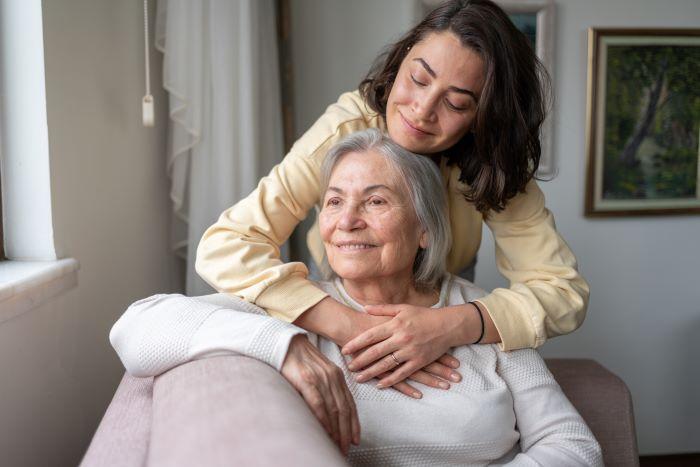
Family caregivers face an immense burden. Considering an estimated 1 in 5 Americans care for a family member with a serious illness or disability, arguably family caregivers are the backbone of the long-term care system in the U.S. Yet, these caregivers get little recognition or compensation — if any at all — for the care they provide. They often suffer worse physical and emotional health outcomes than non-caregivers, and current support systems are inadequate and fragmented.
As for the individuals receiving the care, not enough research has been done to understand how they are impacted.
Duke population health researchers are gathering evidence to show what type of care leads to the best physical and mental health for the care recipients, and how to best support the caregivers themselves. Ultimately, they hope this work leads to better outcomes for everyone involved in family caregiving.
Reframing Caregiver Experiences
A study led by Megan Shepherd-Banigan, PhD, calls for a major shift in how society understands and supports family caregivers. Published in the International Journal of Care and Caring, the study analyzed 40 qualitative studies and found that caregivers face overwhelming emotional, physical, and financial strain — often worsened by fragmented health care systems and social stigma.

Through a partnership with the Rosalynn Carter Institute for Caregivers, the research team conducted a systematic review of qualitative papers that examined the experiences of family caregivers caring for adult and child recipients with physical and mental health impairments.
After the review, the team came up with a universal caregiving framework to group caregivers into distinct profiles that can be used to match caregivers with needed services and supports.
“We were able to take those findings and start to really think about how we could group caregivers based on their experiences,” said Shepherd-Banigan, an associate professor in population health sciences.
Rather than defining caregivers by the illness of the person they care for, Shepherd-Banigan and the research team argue for a caregiver-centered approach that recognizes the complexity of caregiver roles and the toll caregiving takes over time.
Defining caregiver experiences based on the illness of the care recipient alone doesn’t provide sufficient information about what caregivers truly need, Shepherd-Banigan said. A family caregiver who is caring for a loved one with cancer is going to have a different experience soon after the initial diagnosis than when the loved one is facing end-of-life care.
The goal is to get family caregivers to the services they need, helping reduce the burden they experience and increase quality of life.
“If somebody is getting high-quality care at home from a family member or friend who's not overwhelmed, the care at home is going to be better for that person,” Shepherd-Banigan said.
Now that the researchers have created the framework based on the results of the review, the next step is to develop an assessment tool to categorize caregivers into groups and a toolkit that clinics can use, Shepherd-Banigan said.
Using the assessment tool, providers at a medical clinic could help the family caregiver get to the right resources based on which group they fit into.
“There are not a lot of caregiver assessments in general,” Shepherd-Banigan explained. “The caregiver assessments that do exist are often about burden. There is very little that thinks more comprehensively about the resources and unmet needs of the caregiver in their role.” She and her team hope to help fill that gap.
A Combination of Care
Courtney H. Van Houtven, PhD, is doing research focused on the needs of the care recipient. She recently coauthored a study that showed who cares for a person in the home matters. The study, published in Health Economics, reveals that older adults who receive both family and professional home care experience better health and less depression than those cared for by family alone.

In contrast, relying solely on professional caregivers didn’t show significant benefits over family care alone.
The need for family care is common and growing. In the U.S., long-term care is most frequently delivered by family and friends who are often not paid. According to the researchers, 75% of Americans with long-term care needs rely on family care.
While much is known about outcomes of those providing the care, Van Houtven, a professor in population health sciences, said less is known about how the combination of family care with formal home care affects the person receiving the care.
“Surprisingly, there's very little evidence about the relative benefits of these two types of care, even though most people rely on unpaid care because we don't have insurance for long-term care in the U.S. for everyone,” she said.
The researchers used the 2002–2018 Health and Retirement Study (HRS) to examine three types of home-based care combinations: family only, formal only, and both formal and family care.
Van Houtven and the team, which included lead author Norma B. Coe, PhD, from the University of Pennsylvania, examined self-rated health, mobility, and depressive symptoms. They found that having both formal home care and family or friend care led to better self-rated health, better mobility, and lower depressive symptoms compared to those who received family care alone. Having formal care only did not affect outcomes.
The next question that Van Houtven intends to answer is why?
“There's still a lot of work to be done to understand why we found that this combination of care helps people compared to just receiving one type of care in the home,” she said.
The findings of this research have implications for helping families make decisions about their loved one’s care and pointing them toward resources. Van Houtven said the team aims to develop optimal models of care that will help families provide the best care possible for their loved ones.
“The message for medical care providers, the caregivers, and the people receiving care is that adding on and finding ways to get access to formal care does produce benefits for the care recipient,” Van Houtven said. So, it is important to try to “find ways to match people to the resources they're eligible for.”
Van Houtven said in future studies the team plans to examine whether paying family caregivers has an impact on care recipient outcomes.
While these two recent studies were conducted separately, Shepherd-Banigan and Van Houtven have collaborated on numerous research projects over the years, both at the Durham Veterans Affairs Medical Center and at Duke. Their collaborative research has focused on multiple areas, including caregiving of older adults and evaluation of the impact of the VA’s caregiver support program.